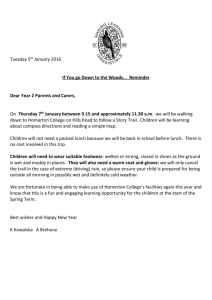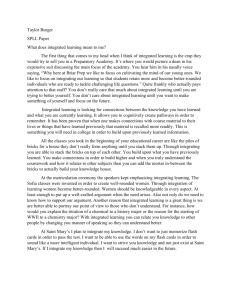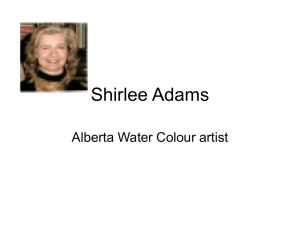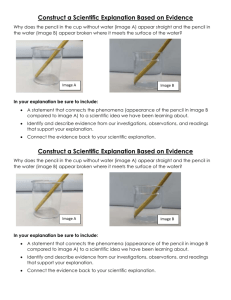Language development pack for Early Years children
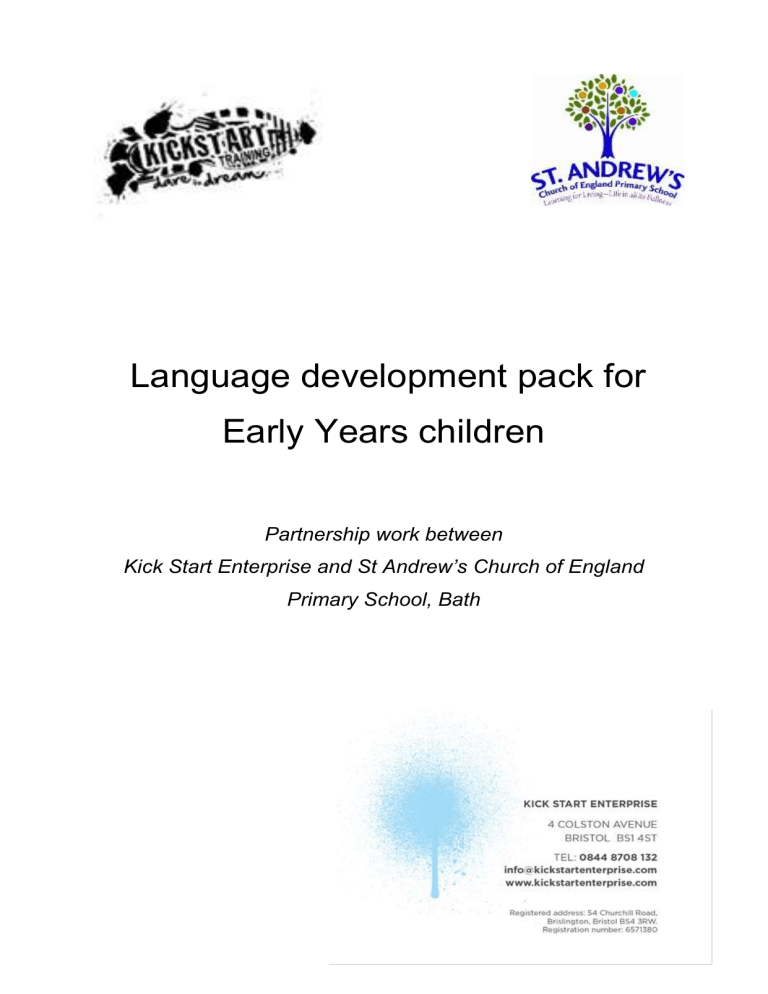
Language development pack for
Early Years children
Partnership work between
Kick Start Enterprise and St Andrew’s Church of England
Primary School, Bath
Language development pack for Early Years children
This pack of key words and phrases for targeted language acquisition in Early Years settings was developed after an observation in a nursery class of a group of EAL children from a variety of different language backgrounds. The children were playing happily with a box of bricks, building towers and other shapes. It quickly became apparent that they had very little language they could share between them in terms of describing the shapes or colours of the bricks, to express what they wanted or to explain what they were trying to do. Most negotiated with gestures or expressions – hardly any words were used at all. The children were able to follow instructions from adults to choose shapes and colours of bricks and put them in directed places but were not able to use the language for themselves.
This led to an acknowledgement that language for play, learning and social negotiation has to be taught explicitly and that children’s acquisition of language should be monitored more rigorously. EAL children acquiring a new language also need to be acquiring language for learning and social interaction but this is seldom learned by listening to peers. The purpose of putting together the lists of words and phrases below is to focus staff on the language demands of an EY setting so they can plan for active language interventions, monitor understanding and encourage and model using the target language in context. Above all staff need to be listening to children and checking what language is really being acquired and used actively and accurately with comprehension.
The words and phrases are grouped according to areas within an EY setting and start with single words, then short phrases and sentences. Nouns are preceded by the correct determiner (a/an/the) as many languages do not have determiners and it is useful to teach children from the start that English does have such grammatical features. Where verbs are listed the past tense form is also given so that children can be taught the language of recount and become familiar with regular and irregular past tense forms.
This is not in any way a definitive list of vocabulary needed by EY children, merely a reminder to staff about how important it is to spend more time on ensuring children’s active use of language is continuously being enhanced through their play and learning experiences. The words, phrases and areas covered are obviously indicative not prescriptive and can be added to and amended to suit individual settings. While the pack was developed with EAL children in mind, all children are liable to benefit from a more rigorous approach to extending and enriching the language available to them.
Teachers’ notes – some ideas of how to use the pack
Organise staff training to ensure the aims and purposes of language development are fully understood and become embedded in everyday practice – staff can also contribute their own ideas for how best to use the lists and to add new vocabulary
Words could be translated for parents (google translate or with help from other parents). Aims/purposes of the initiative should be explained to parents, with the help of interpreters as necessary, at home visits or parent meetings. (Remember first and subsequent languages should be developed in tandem to ensure fluent bilingualism)
Start off with a small number of words and build up over the year
Agree target words of the week – include in planning documents and display around the setting in specific areas
Share target words of the week with parents and encourage them to discuss the meanings of the words in first language as well as English
Talk about the target words with children , elicit correct use in context
Monitor the progression of children’s language – word lists could also be used as checklists for individual children
Choose stories to read which include focus words of the week – draw attention to these in the story
Words used as labels on objects ( remember to use indefinite articles with nouns) , once literacy skills begin to develop
Staff to be more explicit about praising children using new words in context ( and feedback to parents about this)
Words of the week session , all children to contribute a new word/words they have learned during the week
Rewards / incentive schemes for best use of new word, longest brilliant sentence, kindest words to a friend, best reply to a question etc
More talk about talk, its quality , accuracy and the effectiveness of words
At the end of any small group session encourage children to recount what they have just been doing. This will help reinforce any new language learned and will also help them to learn regular and irregular past tense verb forms in context ( I made a ….,
I looked at the ……etc)
Language development in EYFS
Generic language for relationships and social skills hello goodbye how are you? fine, thank you thank you please please can I have a /the ………?
I want
I don’t want do you want …..?
I like
I don’t like
I think
I don’t think
What do you think ?
It’s my turn
It’s your turn yes because no because
Can you help me ?
I don’t understand it feels/sounds/tastes/smells/ looks like excuse me
………… is my friend
Will you be my friend?
Language for painting and chalk an easel a paintbrush a thick paintbrush a thin paintbrush a bib a magnet paper towels the chalkboard chalk paint red blue yellow green black white etc mix ( I mixed the paint) stir ( I stirred …..) splodge dot splash
( I splashed …..) line swirl swoosh
I want to leave the painting to dry
I’ve made a painting/ drawing of a……………………..
Language for trains a piece of track a curved piece of track a straight piece of track a train a tunnel some carriages a bridge an arch a station
Thomas the Tank Engine join ( I joined the ……) connect ( I connected the tracks) add ( I added …..) stop the train the train is going fast/slow the train is going into the tunnel the train is coming out of the tunnel
Outside play the climbing frame the beam the playground the slide the steps the ladder flower beds a table a tyre the sandpit a brush a bat a raquet a spade a wooden horse ( ride, gallop canter, jump ,race) a ball - kick, catch, hit ,stop, roll, throw, carry, bounce, toss, carry
I can run fast ( I ran …)
I can run slowly
I can jump ( I jumped….)
I can slide (I slid….)
I can skip
(I skipped…)
I can roll ( I rolled…..)
I can leap ( I leapt…)
I can play with ( I played….)
I can balance ( I balanced …..) climb up/slide down walk/run forwards/ backward
Construction language lego bricks mobilo stickle bricks brio jungle animals ( and names of animals) zoo animals dinosaurs a car a bus a lorry a tanker put ( I put the ……) stick ( I stuck some …..) balance (I balanced …..)
Can you give me the …… ?
Do you want to play with the …….. ?
Can I play with you please ? ( I played with ….)
Let’s try …….
I can build a tower/ make a house ( I built a …..)
Role play dressing up clothes uniform ( policeman/ woman , fireman/woman) nurse’s uniform a scarf a hat ( with colour, shape , texture word ) a sari a dress trousers a shirt a blouse a jumper/sweater a skirt shoes boots princess costume shalwar kameez what do you want to be?
I want to be a ( I wanted to be a …..) l et’s play ……… ( we played at….) let’s pretend ( we pretended to be ……)
I’m going to be a ( I was a …….)
Language for cooking and kitchen area a pan a pot a frying pan a spoon a knife a fork a wooden spoon a whisk a plate a bowl a cup a mug a chopping board a sharp knife a fish slice a ladle a rolling pin chopsticks stir (I stirred….) chop ( I chopped ……) slice ( I sliced……) mix
( I mixed …..) add ( I added …..) serve ( I served ….)
What will we make ?
I can make a …….. ( I made a …..)
I made this because
Language for playdough and model making playdough plastiscene clay card cardboard box a rolling pin a knife scissors cut ( I cut ….) roll ( I rolled ….) pull ( I pulled……) stick ( I stuck …..) make (I made …..) model ( I modelled …) soft squidgy dry hard wet crumbly sticky
I’ve made a ……..
Look at my ………. pass the …… to please pass me the please can I have ……
Language for the book corner a book a page a story fiction non-fiction the cover the title the author cushions carpet/rug book shelves bilingual books words pictures photographs read
I am reading about
I can read……. ( I read … ) turn the page ( I turned the page ….) please read me a story
I like ……….. ( name of character) because ( I liked ….) my favourite character is
I like books about
It’s a good/funny/sad/happy/ story
The book was ………… because……….
Language for the writing area a pen a pencil a crayon a colour pencil ( or named colours) a piece of paper a rubber a ruler a sharpener a pencil grip my literacy book my learning journal the whiteboard phonics keywords letters capital letters a full stop lines
I can write my name ( I wrote …..)
I can draw a picture ( I drew…….)
I want a sharp/ thick /thin pencil
Please pass me the rubber
Language for drawing and colouring a pencil/pen /crayon felt tips all the colour words a piece of paper / some paper the scissors a picture a glue stick the sellotape colouring in colour in the ……..
I’m colouring in the /my ( I coloured in ….) colour inside the lines cut out the picture draw a line draw a shape
I’m drawing a ……. ( I drew a….)
Look at my picture of a …….
It looks like a …….
Please can I have the (colour) pencil /pen ?
I need some more paper please
Language for water play the water warm water / cold water / hot water water tray an apron a cup a bottle a sieve a beaker a funnel bubbles ( big/small/frothy) boats, fish , names of other sea creatures full/ empty/ half empty floating ( the …. is floating) sinking (the ……is sinking) pour ( I poured ……) stir ( I stirred….) splash/splosh stir the bubbles make it frothy don’t splash please pour the water into the …………. please roll my sleeves up
I want to keep my clothes dry my clothes are wet
I want to dry my hands
Language for Maths/number work a number/ numbers numbers 1-10/10-20 an abacus a number line a number square a counter/ some counters a calculator magnetic numbers beads foam shapes ( and names of shapes) number rods stickle bricks numicon blocks
a number jigsaw counting bears
I can count to …….. ( I counted to ….)
There are … number ………… ( objects) ( There were…..)
I’ve got … number ………..( objects)
This is a ,…….. ( shape name)
This is number …………
Language for welly walks wellies( wellington boots) all in one / waterproofs an umbrella rain clouds wind
(it’s) wet/cold/ hot/ dry it’s raining/ cloudy / windy/ sunny
I’m cold/wet/too hot
I’m/ we’re going for a walk to the ……. ( I/ we went for a walk …..)
I’m putting on my wellies (I’ve put on my ……)
I’m taking off my wellies ( I’ve taken off my ……)
I want to splash/jump in the puddles
I’m splashing/jumping in the puddles…… ( I splashed/jumped)
Please will you hold my hand?
Language for weather and seasons hot ( It’s hot, I’m hot) cold ( It’s cold, I’m cold) wet (it’s wet, I’m wet) windy ( It’s windy) cloudy ( It’s cloudy) snow ( It’s snowy/snowing) rain ( It’s rainy/ raining) frost ( It’s frosty) a rainbow spring ( springtime) summer ( summertime) autumn winter ( wintertime)
Easter
Harvest
Halloween
Guy Fawkes/Bonfire night
Christmas
New Year
Eid Mubarak
Eid Al Adha
Diwali
Chinese New Year
